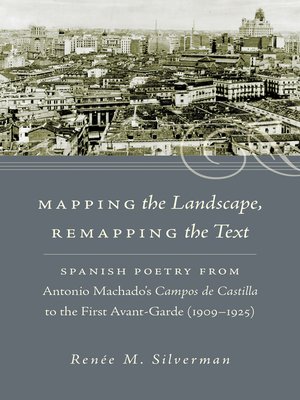Mapping the Landscape, Remapping the Text
ebook ∣ Spanish Poetry from Antonio Machado's Campos de Castilla to the First Avant-Garde (1909-1925) · North Carolina Studies in the Romance Languages and Literatures
By Renée M. Silverman

Sign up to save your library
With an OverDrive account, you can save your favorite libraries for at-a-glance information about availability. Find out more about OverDrive accounts.
Find this title in Libby, the library reading app by OverDrive.



Search for a digital library with this title
Title found at these libraries:
| Library Name | Distance |
|---|---|
| Loading... |
Mapping the Landscape, Remapping the Text: Spanish Poetry from Antonio Machado's Campos de Castilla to the First Avant-Garde (1909–1925) explores the mapping of identity and memory in Antonio Machado's (1875–1939) Campos de Castilla (1912, 1917) before studying its disruption by the avant-garde movements Ultraísmo (1918–1925) and Creacionismo (1910s–1930s). Machado's attribution of identity to the landscape was remapped by the first avant-garde in order to circumvent the placement of identity in textual landscapes that are coded as national or regional, transform the conception of subjectivity and identity through a reconstruction of poetic form, and reposition Spain at the center of the European avant-garde. Renée M. Silverman focuses on the way in which these mappings and remappings affect perspective and perception.
As Silverman argues, both Ultraísmo and Creacionismo employ spatio-temporal simultaneity and the multiperspectivism of abstract visual art idioms such as Cubism to break the bond between people and place that is characteristic of Campos de Castilla. Yet, as Silverman emphasizes, there are some important differences between Ultraísmo and Creacionismo, particularly in Gerardo Diego's (1896–1987) idiosyncratic brand. This book — the first in English to center on Ultraísmo and Creacionismo — contrasts the way in which Ultraísmo's leader, Guillermo de Torre (1900–1971), displaces the subject from the terrain of memory, freeing it to cross borders, with how Diego re-roots identity in the textual landscape so as to restore a sense of collectivity to vanguard poetry.
As Silverman argues, both Ultraísmo and Creacionismo employ spatio-temporal simultaneity and the multiperspectivism of abstract visual art idioms such as Cubism to break the bond between people and place that is characteristic of Campos de Castilla. Yet, as Silverman emphasizes, there are some important differences between Ultraísmo and Creacionismo, particularly in Gerardo Diego's (1896–1987) idiosyncratic brand. This book — the first in English to center on Ultraísmo and Creacionismo — contrasts the way in which Ultraísmo's leader, Guillermo de Torre (1900–1971), displaces the subject from the terrain of memory, freeing it to cross borders, with how Diego re-roots identity in the textual landscape so as to restore a sense of collectivity to vanguard poetry.







